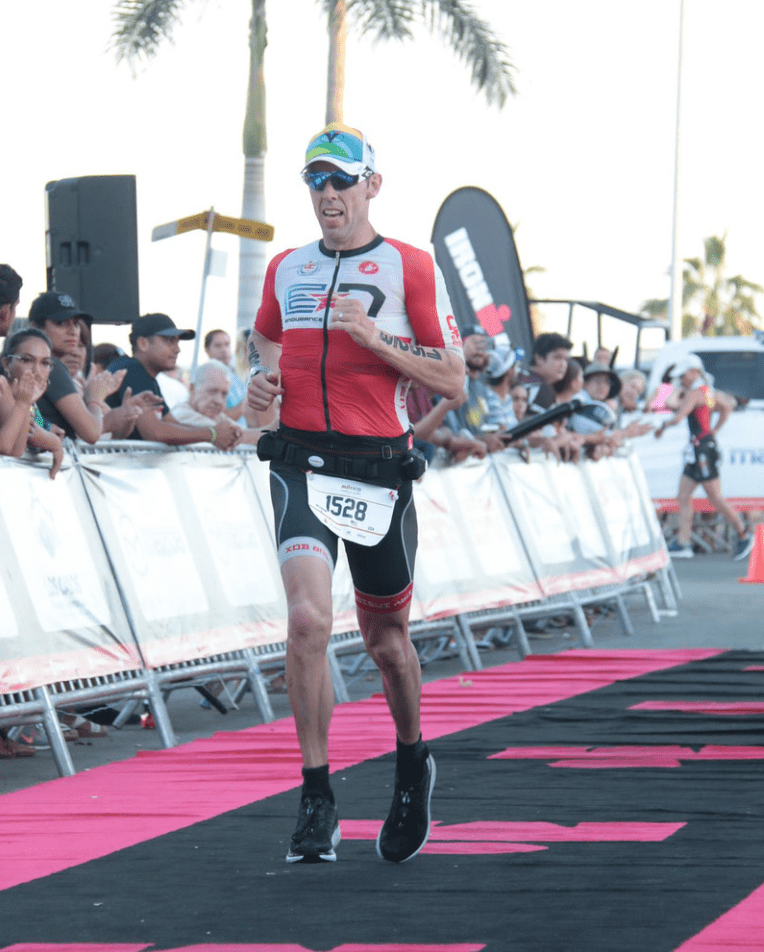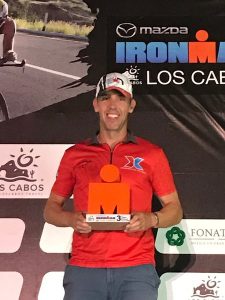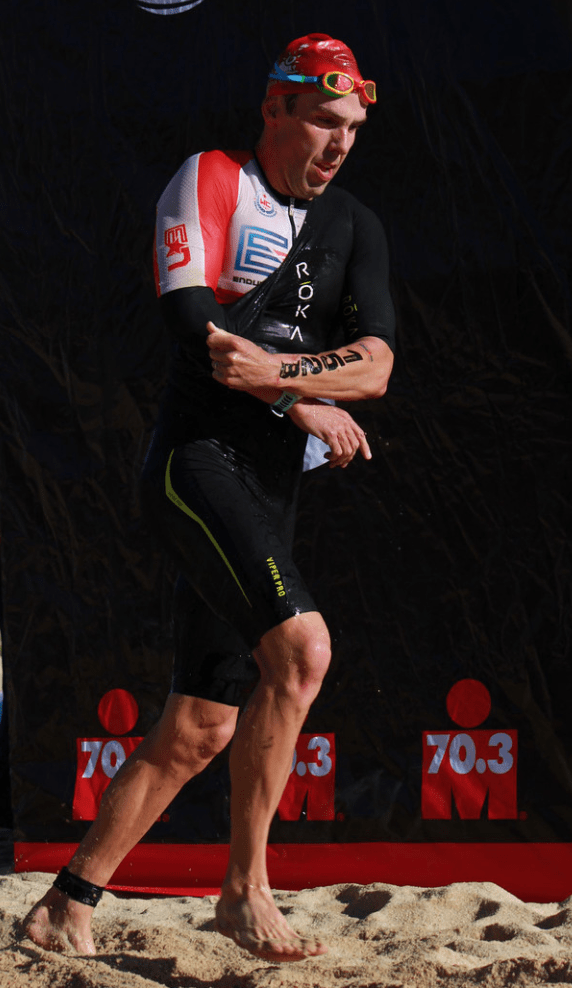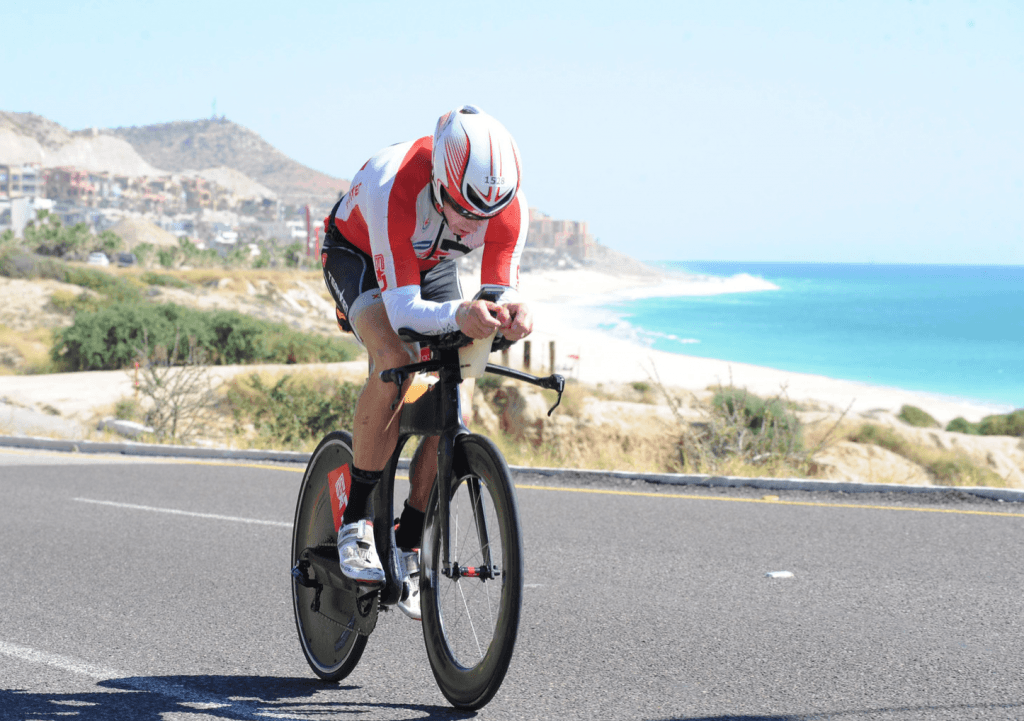When I decided to tackle Ironman Cabo just four weeks after the World Championships, my goal was to carry my fitness forward in order to earn another spot to Hawaii.
I was disappointed with my performance on the Big Island and wanted a second shot. This was to be my 25th Ironman® race, and I wanted it to be a good one.
While I have coached many people through a similar process, this is the first time I did it myself. I thought it would be useful to capture some of the pros and cons of what I did, in the hope that my approach could help you plan out your season ( or adjust it on the fly).
The Background
To be clear I was in the best shape of my life heading into the World Championships. Due to some stomach issues, I was unable to run the marathon at my full potential. I exited that race with minimal fatigue as compared to a normal Ironman®
I did not run myself into the ground and then try and repeat that process four weeks later. All of what you see below is a function of (A) being fit and (B) my body not being as fatigued.
If you wish to read my full race report, check it out on this post.
Accelerated Learning (And Suffering?)
When you exit a race, one of the first things you walk away with is an understanding of what you want to do differently. Having an opportunity to put those lessons learned into practice right away proved to be very powerful.
- I was able to avoid any of those strange unrealistic expectations or strategies that evolve when you have 9 to 12 months between key races.
- I knew exactly how I wanted to handle the run aid stations.
- I was ready to use power on the run.
- I wanted to make some clothing choice changes vs Kona.
- And many more!
Close Climate…Fortunately, the climate between the two races was very similar. The biggest difference was that Cabo has a bit less humidity. This means I was able to carry over a lot of what I had tried in Kona right into Cabo without too many changes.
Residual Fatigue…All that said, I was still pretty tired. It’s important to remember that the effect a race has on your body includes all the work you have done leading up to the day. I knew that I was going to be tired in Cabo, especially on the bike.
While the swim was fine, the second lap of the bike was very difficult and I really had to Back off of my pre-race expectations. Not in a “give up” way, but rather
I had to step away from the goal that I was chasing to refocus on the race I was creating. If anything, being cautious here is what set me up to have success on the day.
Back-to-Back Training Protocols
My approach was more reactive than prescriptive. If you head into your season knowing you’re going to put two races together, you have the opportunity to create something more intentional — and perhaps even more effective.
With my quick turnaround, I chose to focus on maintaining my fitness on the bike and swim and keeping my run as consistent as possible. My workouts had three specific focus points:
Recovering Like a PRO
Another key element was preserving my fitness. This meant actually taking some hard time off after Hawaii. Seven full days of barely any exercise, with some easy spinning (and of course lots of Normatec)
Over the years I have learned I need serious rest in order to rebound quickly. Given the role of exercise in my daily life, this is honestly the hardest part of the process.
Preventing the Fade
By this, I mean not allow my body to slip into full recovery mode. I reverse this process by working in back-to-back 3 to 4-hour rides within 10 days of Hawaii. This re-energized my system and put a halt to the normal process of the training.
Targeting Race Specific Work
- The Swim – I used my Vasa Ergometer to continue doing the same level of swimming I did into Hawaii. There is almost no daily cost to my aerobic system for the swim, so there were no issues there. It was nice to have the Vasa so I could compare power numbers and cadence between the different swim workouts and know I was on track.
- The Bike – I used shorter intense intervals (aka Zwift races) to keep my fitness high, and I did one or two longer rides for the mental aspect. I think there’s no substitute for doing a century ride on Zwift as compared to the mental challenges of riding 112 miles in an Ironman®.
- The run – I was basically tapering the entire time, as Kona was my last long run. Most of the runs were short, approximately 5 miles. The longest run was just over 90 minutes on a treadmill. I did all of these runs at a very relaxed effort, a pace much more aligned with my race pace. So no real run tempo or similarly challenging run pace. I made my indoor runs harder by playing with the grade on the treadmill and also using the space heater in my garage.
Indoor Training
With the exception of two runs (both about 45 minutes long), all of my training in the four weeks between the two races was done indoors. Given the cooler temperatures and weather variances of the Fall, this made life easier. Not to mention the challenges of having my kids in school and all of the extracurricular activities they are involved with.
Being indoors eliminated a ton of friction and actually created more opportunities for me to be consistent. Working from home is always been a challenge but with a full gym in my basement, I literally have no excuses standing between me and a decent workout.
I strongly encourage people to invest money in establishing a good pain cave. I believe every dollar you spend on making your indoor training set up engaging and effective will pay massive dividends downline.
The Value of Data Diminishes Over Time
While I don’t use charts to create my training, I do review them as I follow my progress. Looking at my normal charts On Training Peaks that I’ve used in the past, I was perplexed as to how best to manage my effort into Cabo. Due to the Peak / Taper / Race process, I had already done twice in two months, my current data looked nothing like my July or September builds.
My Endurance Nation teammates stepped up and offered some very sage advice – to trust my body and do the work I needed to do to feel ready regardless of what the data told me. The data itself gave me zero clues as to what a successful third Ironman in three months should look like. Rather than use my data to plan, I decided instead to focus on the workouts that I knew would have maximum impact and reserve the charts for future review.
The Swim
The swim course was very similar to Hawaii. It’s an ocean swim with very big swells and no wetsuit. Since I swam well in Hawaii, I was confident I had good momentum from the midpoint of my season. My work on the Vasa Ergometer really shows me the value of consistent swimming and higher cadence swimming and the technology of my Roka Viper Pro Swimskin really gave the opportunity for my swim fitness to shine.
My first step was to get into the right mindset of swimming which was to be competitive. Encouraged by many of you, I decided to seed myself closer to the front in order to stick with the lead group versus just getting in my groove. I am a notoriously bad drafter and instead rely on being a strong cyclist and runner to carry me through the day.
This time around, having just come from Hawaii, I was ready for contact and getting into the scrum. I seeded myself accordingly and did my best to stay with the group for the first 500 meters. At the first turn the group really split up due to the currents but my bilateral breathing kept me on a course and significantly reduce the length of the swim that other people faced.
I was reminded of the importance of higher cadence of being open water. The swells and chop and wind being what they are, make your ability to stay taught in the water and straight as possible is a significant advantage. Higher cadence swimming creates this dynamic, but it can be muscularly taxing. Being able to train indoors at a higher cadence on my Vasa prepared me for this workload and made the ocean swim simply fly by. As a result, I had one of my best swims ever (including a PR) and felt 100% ready coming out of the water.
The Bike
I Had high hopes for the bike but was very wary of the weather (hot, windy) and the terrain (rolling with two decent hills on each lap). The variability of riding on the terrain with the heat in tough conditions is such that most of us are much slower than predicted.
Preparing for Fatigue – I set up my entire ride understanding that the second half of my ride was going to be very challenging. I often have some lower back discomfort around the three-hour mark, and fully expected to have that sooner (which I did!) In Cabo. Rather than force the bike, I made the call to roll with how I felt. My ultimate goal was to be fast all day long — not just fast on the bike. I broke the course down into mental sections and set some guidelines for both power and heart rate to keep myself in check. My Ventum One held strong as we worked like a well oiled (aka sweat) machine all day.
Power Early, Heart Rate at the End
I had two sets of metrics on the bike: Power and Heart Rate. I used Power early as a whip to get me moving and to stay aggressive on the course. This is when I passed most of the people who had beat me out of the water. I was able to ride a little bit harder with the temperatures lower and the roads a little busier with more athletes from the 70.3 race that was going on at the same time.
After the first lap, and specifically that second climb up to the airport, I could tell the heat of the day was on. The winds had also picked up, making the start of the second lap very challenging.
I made the strategic decision to switch from Power to Heart Rate and to keep my effort as steady as possible. Given how hard the bike felt at that moment, I realized that I needed to be strategic versus just strong.
My power file shows first and second laps are significantly different. Almost 9/10s of intensity factor was lost – .75 To .66 – Between the two loops.
Yet my heart rate was able to build all day. And even my speed stayed high, as I focused on riding much easier up hills but much harder down them. In many ways, it was almost two different bike rides! But this allowed me to exit the bike feeling pretty good about my day and positioned well within the field, ready to run.
Value of Pre-Riding Your Bike Course
This is the first Ironman® I’ve done in a long time where I had not done any research on the course itself. All I had was what I’d seen on my computer. I did a brief ride on one or two key sections of the course, and we drove the entire course — But there’s no substitute for hands-on experience.
Without a doubt, the high level of traffic on the road was intimidating. In retrospect, I could have easily gotten on my bike on the first day and at least ridden the course in one direction — looking back on my experience after the race I think I would’ve been better mentally prepared with experience on the course.

The Run
This is where I was looking to make some of the biggest changes coming out of Hawaii. I was very disappointed with my performance there and the multiple factors that impacted my ability to run To my (perceived) potential. As a result, the section is a little more detail than the first two.
Actionable Metrics for the Run
Coming out of Hawaii I allowed the subjective experience of the run in the heat to affect my ability to execute.
I resolved in Cabo to use the numbers on my watch as a guide as opposed to the feedback I was getting from my body. I restructured the fields on my Garmin 920XT to show my Stryd Power Data: Cadence, Pace and Total Run Time instead of Heart Rate as the main metric. In fact, I had to go to another screen just to see My heart rate!
My key metrics for the run were Power, Cadence, and Lap Time.
- I use Power because I have specific targets that I correlated with my long-run pace I have been doing on the Treadmill.
- I use Cadence because it helps make sure I am running with good form regardless of my speed.
- Lap Time because it shows me whether or not I am within the target time required to be as successful as I had planned prior to the race. With those three numbers in alignment, I could toggle over and just confirm that my Heart Rate was in a good place.
Instead of just settling into a Heart Rate zone, I wanted instead to use the metrics above to create a feeling of “the right work” early on the run. This way I would be able to adapt to it and embrace that level of “work” as what I was going to try and continue all day.
In other words, showing up with an aggressive race plan targeted towards qualifying meant that I needed to use my experience to create the conditions within which I wanted my body to operate. Using data and planning to fuel my mental toughness.
Running In the Present
Looking back on my performance in Hawaii, I spent a great deal of time on the run thinking about everything I was going to do in the future versus focusing on what I was doing at that very moment.
All of those metrics I listed above, such as Power and Cadence, allowed me to stay in the present moment because it was something I was doing right now. I was constantly drifting off thinking about future laps – it was a four-lap course! I was alternately either making up stories about how awesome I was going to be at the end, or I was worried about what was going to happen to me in Lap Two or Three.
Elation or despair. Neither of which actually make me a better racer.
Every time I caught myself doing that I simply brought myself back to the present moment.
Here’s a great example — there was a period of time Mid-race where I was Debating whether or not I was going to walk at the next Aid station. It was clear that my Body and Mind were already having a debate about what was going to happen with my race. My body was trying to change the narrative of my race, and it almost broke through my mental defenses.
I had to respond, and quickly:
“You’re only going to walk if you have to walk…not if you want to walk”
Don’t waste time thinking about what you’re going to do at Mile 15, or what you’ll eat at this aid station on your second lap, or what you are going to tell your friends at the finish line. Focus on doing what you’re doing right now to the best of your ability. Everything else will take care of itself.
Interim, Early Rewards
Aid stations themselves are a great mental break. They are a chance to “reward” yourself for running between the aid stations. I did my best to break the course up into different sections. I ran through several aid stations being as efficient as possible, choosing to spend a little more time at every third or fourth a station as a chance to truly refuel.
Rather than starting to walk the aid stations at the outset, I was using my data and my focus on creating a sense of momentum on the course which I was keenly interested in sustaining all day.
There was also one pretty steep hill where the course crossed a bridge. When I got to the top of the hill the first time I had to stop to tighten my shoelaces (I hadn’t put them on properly in transition, especially with all of the sand). Stopping here for 10 seconds become my reward point every 6 miles.
I don’t know if my shoelaces really needed tightening or not, but that was the one place where I was willing to stop all day. All the other times I wanted to stop I could say to myself, “Nope!. This is not the bridge. This is not where you stop.”
By setting a specific place where my reward was going to happen, I had also defined all the other places where it would not happen, and that also kept me on point.
Refocusing My Nutrition
As many of you know I have a very detailed nutrition plan that often has me eating more calories than most people think is feasible. I have found that competing at a high level (as a bigger athlete) brings with it a significant fueling requirement.
Drink More and Eat Less during Hot Races — Talking with Endurance Nation Member Mike Roberts after Hawaii, I heard how he changed his nutrition on the fly because of all the fluids he was consuming in the heat. Mike talked about not really eating very much because of all the calories he was consuming from the Gatorade Endurance on the course. Heading into this race I made the decision not to be a slave to my nutrition plan and instead to listen to what my body needed. I think this is very important for hotter races were the fluid demands in your body are significantly higher than just the food.
While I normally get off the bike and go through three gels in the first half of the run before changing to Clif Bloks, this time I didn’t. I had consumed so much Gatorade Endurance and fluids on the bike, that I opted to not touch my gels (forgoing 300+ calories). Instead, I skipped ahead to the Clif Bloks every two miles and continued with the fluids.
This really allowed me to continue digesting & cooling while I ran and it didn’t impair my stomach at all. At no point in time did I feel like I was running out of energy or struggling with my fueling on the run. The calories were enough, and more importantly, I had tipped the scales in the favor of hydration which set me up for success.
Conclusion
While my “Three Ironman® Races in Three Months” plan was successful, It’s not something I would recommend to everyone. However, you do learn a great deal about yourself both mentally and physically in this period of time. Overall the biggest takeaways were:
Significantly Higher Swim Volume and Frequency — Completed with my Vasa Ergometer, I developed a level of total body fitness and muscular development I have not seen in years which made body composition easy.
Significantly Higher Intensity & Fitness on the Bike Thanks to Zwift — Periodic races and better weekend rides with the Team Have pushed my cycling to new levels of fitness. There was no way I thought it would be possible for me to get stronger on the bike after years of trying…and certainly not indoors! Without a doubt these new (higher) numbers are real, and more importantly a result of quality training, not simply higher volume. I am looking forward to exploring this more in the future.
The Importance of a Steady and Not Speedy Run — Being fast at a Half or Full Ironman® is an art unto itself. But the easiest way to be fast is to not slow down.
Training my run to be consistent all year versus speedy gave my body a break and allowed me to continue to grow on the bike in a way that was not possible in past seasons.
Endurance Nation’s Run Durability Program (RDP) is predicated on those same principles of consistency and frequency and the cumulative impact of both. If you’ve spent a ton of time really working hard to get faster without much luck, Run Durability might be just the right thing for you this Fall / Winter.
Want to dive even deeper into data and race prep? Wondering if the community of Endurance Nation is for you? Become a Team Member.






Leave a Reply